Welcome to our new followers: Resti, Resti (apparently his twin brother :lol:), Pablo, Rikardo Matos (I like your Michel Vaillant avatar very much), and Conry43 (who makes no mystery of his/her favourite scale). Enjoy your stay here, and don’t hesitate to post comments!
A little history
Citroën replaced its C4/C6 range with a brand new car in 1932. Though officially named – rather plainly – 8, 10 or 15CV, denoting the fiscal ratings of its three variants, the new model was christened “Rosalie” by the public, after a successful Citroën record car of the time. The name is still attached to the range.
Once again Citroën came up with a relatively conventional automobile, but highly rationalized mass-production allowed the company to offer as standard equipment refinements that were unavailable from its main rivals. The Rosalie’s main novelty over its predecessor was its synchromesh gearbox on the two upper gears.
The C4/C6’s engines (1.8-litre four and 2.7-litre six, respectively) were carried over to power the 10 and 15CV, receiving only minor improvements in order to boost outputs through slight RPM increases. On the other hand, the 8CV enjoyed a completely new design, a 1.5-litre four that proposed poor performances, but extremely good reliability, an attractive combination for the cheapest model in the range. After being introduced during the C4/C6’s existence, “floating power”, a Chrysler patent, was also back. This technology allowed to limit the vibrations transmitted to the car’s structure by the engine, by installing the latter on rubber mounts rather than directly bolting it onto the chassis, as the practice had been since the birth of automobiles. Another element favouring superior comfort were the new Pullman seats, offered on all Rosalies.
The car appeared in a wide variety of models and bodies in 1932, but was already modernized by 1934, becoming the NH (for Nouvel Habillage, literally “new dressing”). The most obvious improvement of the NH was its slight streamlining, more fashionable than really efficient. Citroën’s new designer, Flaminio Bertoni, gave a modest slant to the Rosalie’s front grille and windshield. Actually, the biggest improvement was invisible: a brand new independent front suspension through torsion bars.
This new suspension arrangement, though it did a lot to perfect the car’s handling, was paradoxically announcing the coming end of its career, as the system was actually tested for Citroën’s revolutionary automobile, the Traction Avant. Its introduction a few months later should have tolled the knell of the suddenly-wrinkled Rosalie. As it turned out, it didn’t.
Despite being Europe’s largest automobile manufacturer and an apparent success, Citroën was near-bankrupt, ruined by its incessant innovations and the extremely high costs of retooling for each new model – ironically, Citroën’s rivals using much more traditional building techniques than the company’s Ford-inspired methods didn’t have to shoulder such a burden. André Citroën lost control of the factory he had created to Michelin, the tyre manufacturer. Citroën’s new owners were not willing to gamble the company’s future on a single model. Rushed into production, early Traction Avants indeed proved insufficiently developed and troublesome for their not-so-happy owners. Therefore, a reassuring line of Rosalies was kept in Citroën’s range. Though reduced in size, this more traditional offer continued to enjoy a large success until 1938. By then, the Traction Avant had been perfected and its sales were peaking out, so the continuation of its predecessor had become pointless.
About the models
Model: Citroën 8CV “Rosalie”
Year: 1933
Maker: Universal Hobbies
Scale: 1/43
Distributed by: Atlas as no.7 of its Passion Citroën press series
Acquired: brand new, in December 2004, in Souillac, France
Universal Hobbies once again designed a fine model for Atlas’ dedicated series of Citroëns, but unfortunately workmanship is not worthy of this effort. My rating is 10/20.
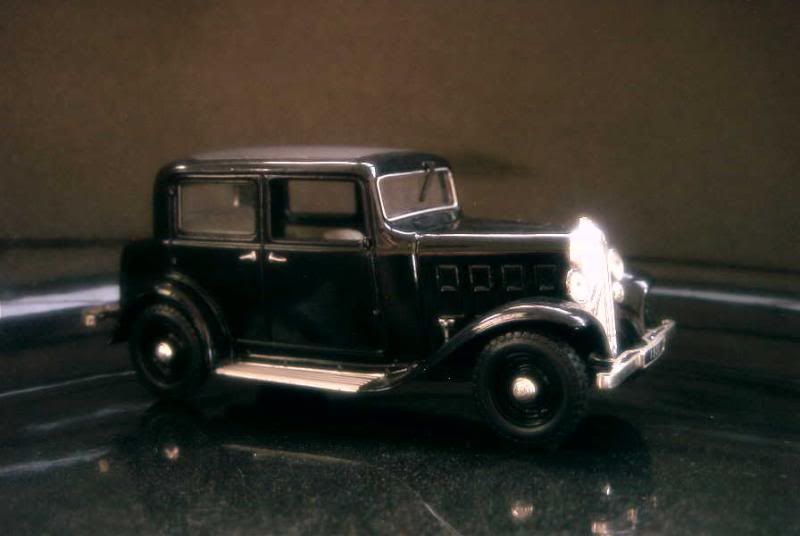
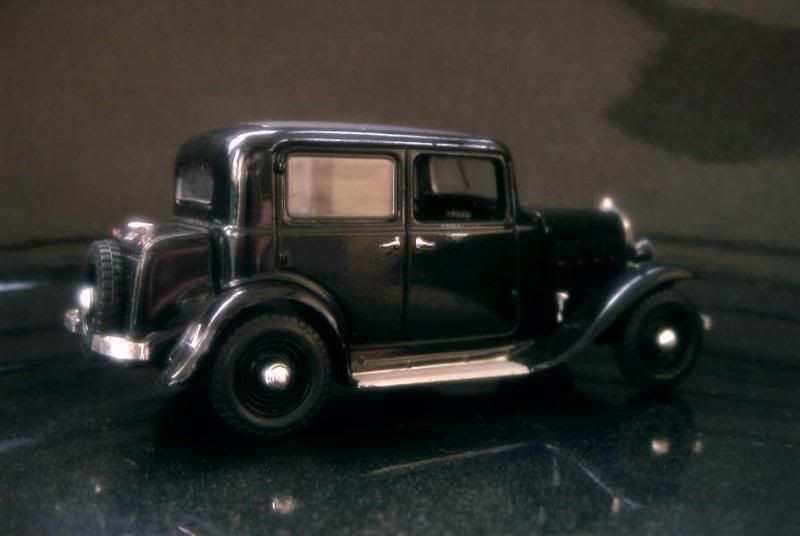
Model: Citroën C4-8 “Rosalie” 500 kg
Year: 1934
Maker: Universal Hobbies
Scale: 1/43
Distributed by: Atlas as no.36 of its Véhicules postaux d'hier et d'aujourd'hui press series
Acquired: brand new, in July 2006, in Souillac, France
The Rosalie range also included trucks, but they retained the C4 name. Note that a diesel engine was even experimented at the time, though it wasn’t put on sale.
This postal Rosalie is from a different press release, but has to be credited to the same manufacturer and the same distributor as the previous model. Overall quality is better here, so let’s give a 13/20 to this die-cast.
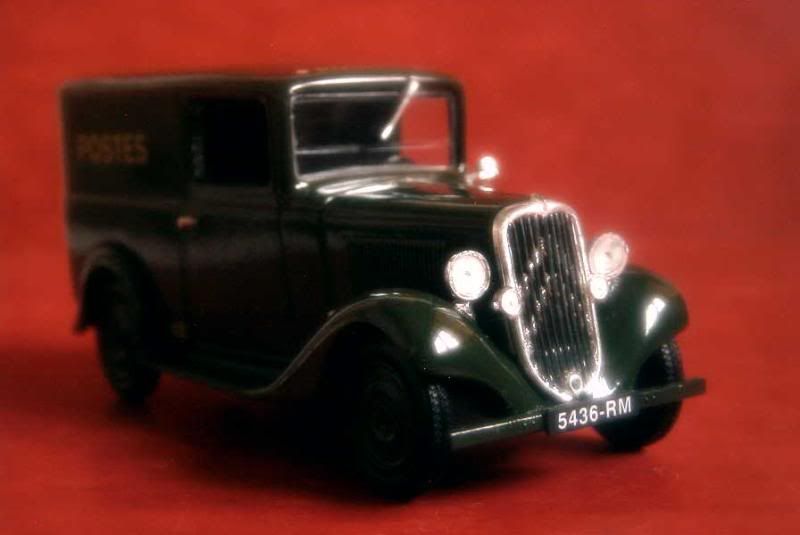
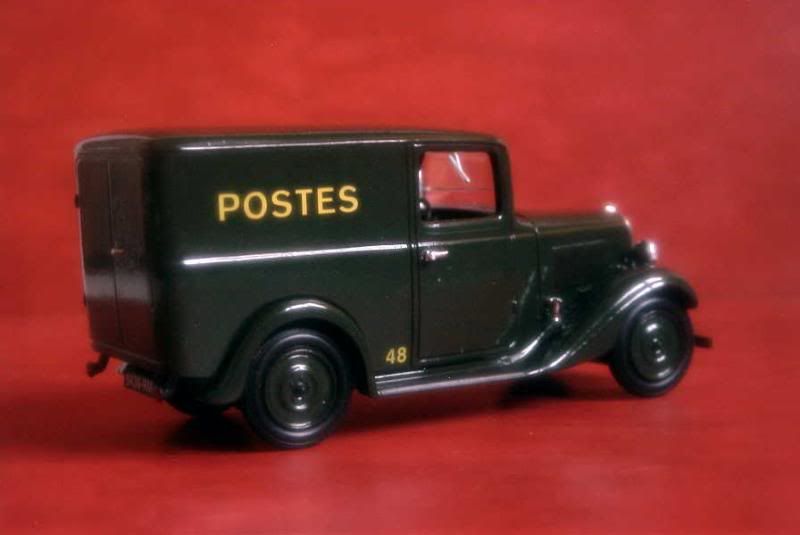
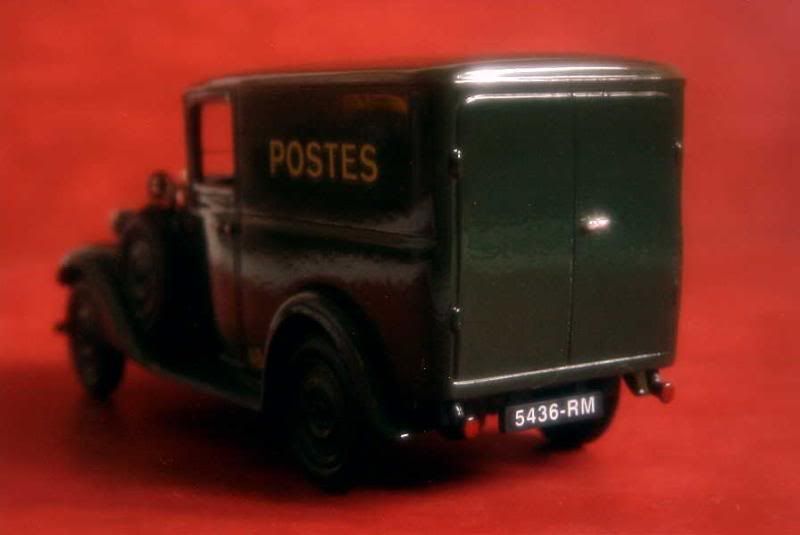

A little history
Citroën replaced its C4/C6 range with a brand new car in 1932. Though officially named – rather plainly – 8, 10 or 15CV, denoting the fiscal ratings of its three variants, the new model was christened “Rosalie” by the public, after a successful Citroën record car of the time. The name is still attached to the range.
Once again Citroën came up with a relatively conventional automobile, but highly rationalized mass-production allowed the company to offer as standard equipment refinements that were unavailable from its main rivals. The Rosalie’s main novelty over its predecessor was its synchromesh gearbox on the two upper gears.
The C4/C6’s engines (1.8-litre four and 2.7-litre six, respectively) were carried over to power the 10 and 15CV, receiving only minor improvements in order to boost outputs through slight RPM increases. On the other hand, the 8CV enjoyed a completely new design, a 1.5-litre four that proposed poor performances, but extremely good reliability, an attractive combination for the cheapest model in the range. After being introduced during the C4/C6’s existence, “floating power”, a Chrysler patent, was also back. This technology allowed to limit the vibrations transmitted to the car’s structure by the engine, by installing the latter on rubber mounts rather than directly bolting it onto the chassis, as the practice had been since the birth of automobiles. Another element favouring superior comfort were the new Pullman seats, offered on all Rosalies.
The car appeared in a wide variety of models and bodies in 1932, but was already modernized by 1934, becoming the NH (for Nouvel Habillage, literally “new dressing”). The most obvious improvement of the NH was its slight streamlining, more fashionable than really efficient. Citroën’s new designer, Flaminio Bertoni, gave a modest slant to the Rosalie’s front grille and windshield. Actually, the biggest improvement was invisible: a brand new independent front suspension through torsion bars.
This new suspension arrangement, though it did a lot to perfect the car’s handling, was paradoxically announcing the coming end of its career, as the system was actually tested for Citroën’s revolutionary automobile, the Traction Avant. Its introduction a few months later should have tolled the knell of the suddenly-wrinkled Rosalie. As it turned out, it didn’t.
Despite being Europe’s largest automobile manufacturer and an apparent success, Citroën was near-bankrupt, ruined by its incessant innovations and the extremely high costs of retooling for each new model – ironically, Citroën’s rivals using much more traditional building techniques than the company’s Ford-inspired methods didn’t have to shoulder such a burden. André Citroën lost control of the factory he had created to Michelin, the tyre manufacturer. Citroën’s new owners were not willing to gamble the company’s future on a single model. Rushed into production, early Traction Avants indeed proved insufficiently developed and troublesome for their not-so-happy owners. Therefore, a reassuring line of Rosalies was kept in Citroën’s range. Though reduced in size, this more traditional offer continued to enjoy a large success until 1938. By then, the Traction Avant had been perfected and its sales were peaking out, so the continuation of its predecessor had become pointless.
About the models
Model: Citroën 8CV “Rosalie”
Year: 1933
Maker: Universal Hobbies
Scale: 1/43
Distributed by: Atlas as no.7 of its Passion Citroën press series
Acquired: brand new, in December 2004, in Souillac, France
Universal Hobbies once again designed a fine model for Atlas’ dedicated series of Citroëns, but unfortunately workmanship is not worthy of this effort. My rating is 10/20.


Model: Citroën C4-8 “Rosalie” 500 kg
Year: 1934
Maker: Universal Hobbies
Scale: 1/43
Distributed by: Atlas as no.36 of its Véhicules postaux d'hier et d'aujourd'hui press series
Acquired: brand new, in July 2006, in Souillac, France
The Rosalie range also included trucks, but they retained the C4 name. Note that a diesel engine was even experimented at the time, though it wasn’t put on sale.
This postal Rosalie is from a different press release, but has to be credited to the same manufacturer and the same distributor as the previous model. Overall quality is better here, so let’s give a 13/20 to this die-cast.







9 comments:
Very, very old cars.
Greets.
Thanks for stopping by Manuel (it will take me some time to get the habit of calling you by your new name ;) )!
Great looking Citroen, Laurent, those 1930s automobile have that gangster look!!
:lol: Thanks Resti!
Wishing you and your wife a meaningful Christmas and a prosperous New Year! :-)
All my greetings and best wishes in return to you and your family! Merry Christmas to all the readers of this blog! :)
Hello dear friend!
I've changed the name of my blog, and the aspect of it.
now it call Estrada 43 and it's adress is:
http://estrada43.blogspot.com
Best Regards,
PGAV
Me scale is 1/43....
Best Regards!
sorry for me bad english.....sorry
Hello Conry43, and thanks for your post... Nevermind about your English (anyway it's well good enough to understand)!
Regards,
Lorenzo.
Post a Comment